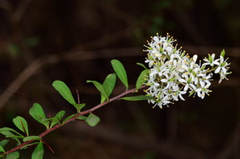
By Terri Allen
THE summer sound of jingling in the bush heralds seed time for bursaria. Bursaria spinosa, an attractive drak green shrub to eight-metre tree, goes by a variety of names: sweet bursaria, blackthorn, native box, kurwan, Tupy or Christmas tree (the Tasmanian name as it flowers profusely on dry rocky hills at Christmas time).
THE summer sound of jingling in the bush heralds seed time for bursaria. Bursaria spinosa, an attractive drak green shrub to eight-metre tree, goes by a variety of names: sweet bursaria, blackthorn, native box, kurwan, Tupy or Christmas tree (the Tasmanian name as it flowers profusely on dry rocky hills at Christmas time).
Named from the Latin ‘bursa’, which means purse (think bursary and bursar), in reference to the seedcase shape, the seeds rattle like coins jingling in a purse.
With leaves alternate and highly variable in size (we have both large- and small-leaved vrieties locally), spring juvenile branches and pyramids of creamy white flowers which are delicately fragrant in spring and summer, Bursaria spinosa is widespread in Victoria and found in Tasmania, NSW, Queensland and SA. Although there are only a few isolated plants in the Heathlands, it is plentiful along the Bunurong, Inverloch foreshore and the Tarwin Lower Road.
Bursaria is in the Pittosporaceae family, along with Common appleberry, white marianth and the two local weed species, sweet pittosporum and sollya.
As well as being a beautiful plant in the garden, it is invaluable as a food source in the bush for spiders, butterflies and other insects. Its worth in shelterbelts and tree plantigs is immeasurable for it attracts and feeds native wasps in summer, which then lay their eggs in nearby Christmas beetle larvae, thus preventing defoliation of neighbouring trees.
To grow from seed, refrigerate the dry seed at 2-4 degrees centigrade for three to four weeks before sowing a few to a pot in Jule/July (temperatre 5-10 degrees) as the seed needs cold conditions to germinate.
So the next time you hear coins jingling in the bush …
With leaves alternate and highly variable in size (we have both large- and small-leaved vrieties locally), spring juvenile branches and pyramids of creamy white flowers which are delicately fragrant in spring and summer, Bursaria spinosa is widespread in Victoria and found in Tasmania, NSW, Queensland and SA. Although there are only a few isolated plants in the Heathlands, it is plentiful along the Bunurong, Inverloch foreshore and the Tarwin Lower Road.
Bursaria is in the Pittosporaceae family, along with Common appleberry, white marianth and the two local weed species, sweet pittosporum and sollya.
As well as being a beautiful plant in the garden, it is invaluable as a food source in the bush for spiders, butterflies and other insects. Its worth in shelterbelts and tree plantigs is immeasurable for it attracts and feeds native wasps in summer, which then lay their eggs in nearby Christmas beetle larvae, thus preventing defoliation of neighbouring trees.
To grow from seed, refrigerate the dry seed at 2-4 degrees centigrade for three to four weeks before sowing a few to a pot in Jule/July (temperatre 5-10 degrees) as the seed needs cold conditions to germinate.
So the next time you hear coins jingling in the bush …